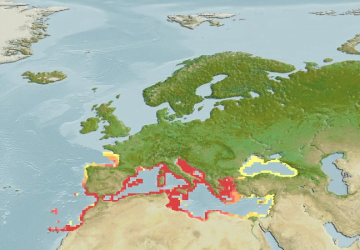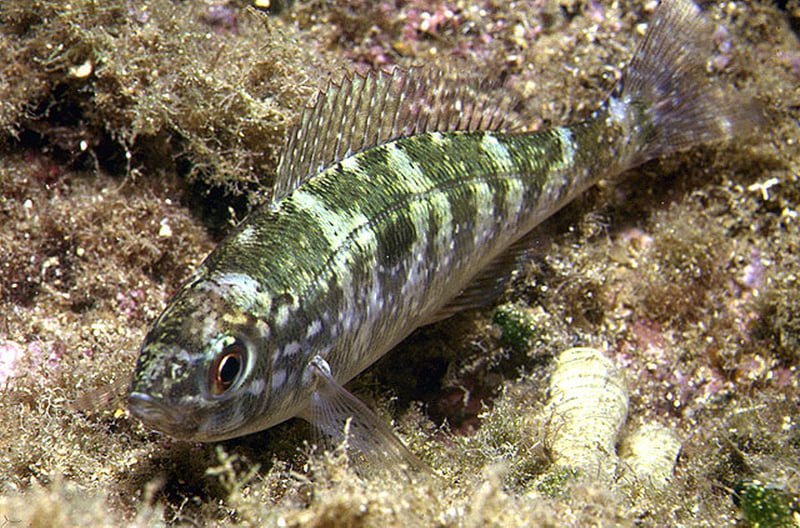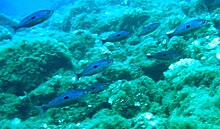Spicara Maena
– Blotched Picarel –

| Conservation status |
|---|
 Least Concern (IUCN 3.1)[1] |
| Scientific classification |
Spicara maena
(Linnaeus, 1758)[2]
| Kingdom: | Animalia |
| Phylum: | Chordata |
| Class: | Actinopterygii |
| Order: | Perciformes |
| Family: | Centracanthidae |
| Genus: | Spicara |
| Species: | S. maena |


Spicara maena, the blotched picarel, is a species of ray-finned fish native to the eastern Atlantic Ocean, the Mediterranean Sea and the Black Sea. The male grows to a maximum length of about 25 cm (10 in), and the female reaches 21 cm (8 in). This fish is fished commercially in some areas.[3]
Genetic studies have confirmed that Spicara flexuosa is a separate species, not a synonym for Spicara maena[4][5]
[smartslider3 slider=239]
Description
Spicara maena is a fairly deep-bodied fish, with males reaching a maximum length of about 25 cm (10 in) and females 21 cm (8 in).[6] The upper jaw is protrusible and the mouth contains several rows of small teeth.[7] The single dorsal fin has eleven spines and twelve soft rays and the anal fin has three spines and nine or ten soft rays.[7] There are sixty-eight to seventy scales on the lateral line.[6] This fish is blue-grey above with silvery sides and a scattering of small dark spots. There is usually one large dark blotch above the tip of the pectoral fin.[6] Spicara maena is a rather variable species. It has many synonyms across its wide range and is often confused with the common picarel Spicara smaris.[3]
Of oblong body, a little compressed, this fish is generally characterized by a back of blue or green color, intense and silvery , underlined by golden lines. Its sides, of a silvery white, sometimes with bluish dotted lines, are marked with a clear rectangular black spot , located between the lateral line and the edge of the pectoral. During the night, this stain tends to disappear. The operculum, and sometimes the head, are striped blue. It should be noted that females and young have a much duller livery. As often, we keep in mind that the coloring data are very variable and are not sufficient for a certain identification: seasonal, sexual and age variation.
Average size between 12 and 20 cm, some males can reach 25 cm and the largest individuals have a bump on the back of the neck. Females are always smaller and lower. The length of the head is less than the height of the body.
The mouth is very protractile *: the upper jaw stretches into a tube. It contains small sharp teeth.
The dorsal fin is continuous and not notched (includes eleven spines and a dozen soft rays); the pelvic has a spine and 5 rays; the caudal is forked, formed of two hollow and pointed lobes. There is no thorn on the operculum. The lateral line * is continuous from the back of the eye to the caudal.
Distribution and Habitat
Spicara maena is found in the Eastern Atlantic, the Mediterranean Sea and the Black Sea. Its Atlantic range extends from Morocco and the Canary Islands northwards to Portugal. Its depth range is about 30 to 90 m (98 to 295 ft). It lives near the seabed over sandy and muddy bottoms and in seagrass (Posidonia oceanica) meadows.[8]
Biotope
Mendoles generally live in small schools made up of individuals of the same size, sometimes mixed with other fish ( bugs , castagnoles , etc.), near the coasts and between two waters. They appreciate rocky bottoms rich in algae, sandy, muddy or seagrass, most of the time between 5 and 30 m, but sometimes up to 200 m deep in winter. They are much more coastal in summer. They are found at night motionless on the seabed, in Posidonia meadows or on rocks. They are classic companions of the landings.
Biology
Spicara maena is a gregarious fish that moves in schools and feeds on small benthic invertebrates[7] and zooplankton. It is a protogynous hermaphrodite, starting life as a female and later changing into a male.[8] In a study in the Gulf of İzmir in the Aegean Sea by Soykan and colleagues it was found that there are almost five times as many females as males and that the change of sex on average takes place within the length range 14.5 to 15 cm (5.7 to 5.9 in) and that all fish longer than 18 cm (7.1 in) are male.[3] A study off the eastern central coast of the Adriatic Sea by Dulčić and colleagues found that the sex conversion on average happened between 17.5 and 18 cm (6.9 and 7.1 in) and that any fish longer than 19.8 cm (7.8 in) were male.[9] The females become mature at the age of two years and spawning takes place between March and June in the Aegean,[3] and between August and October further west in the Mediterranean. The male digs a hollow on the seabed and the female lays eggs with a sticky surface in this nest.[7]
Similar Species
In the genus Spicara , another species is very similar: the picarel, Spicara smaris , whose head is much smaller and the body slender and elongated; its dorsal fin is straight; its back is brown or greyish yellow.
Alimentation
It is a planktonophagous fish * during the day, but at dusk it also feeds on small benthic animals * (crustaceans, molluscs) and even plants.
Reproduction
This fish is hermaphroditic * protogynous *, that is to say that the sexual inversion is carried out in the direction first female, then male. The sexual maturity of females arrives at two years, that of males at three years. The males then display a more intense blue color. Depending on the location, reproduction takes place from spring to autumn, at a shallow depth (between 10 and 20 m) where the males gather and parade above the sand. The sticky eggs are laid in holes prepared by the males where they are immediately fertilized. The males then ventilate and protect them.
Various Biology
The genus Spicara has posed great problems for systematists to describe each species. Indeed, the coloring of these fish is very variable, according to the sex, the sexual maturity, the sexual inversion but also the seasonal modifications. Also, the number of described species greatly increased after Linnaeus. However, since 1950, studies have shown that a simplification was possible and even, in 1971, by the study of crystalline lenses, that this genus would probably only include two local species S. maena and S. smaris .
Further Information
The meat of the mendole is edible (frying) but does not meet with great success because it is full of bones. It was even, at a certain time, considered unfit for consumption (“mange-mendole” was then a serious insult!).
